Panel Beating - 19th March 2006
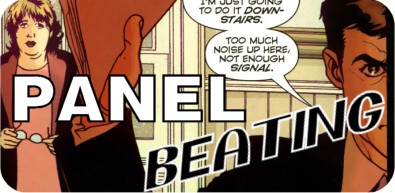
Well, let's start with a rant - I'm very annoyed at my LCS this week. Perhaps I should have expected that, as a shop that only tends to order in about five copies of the most popular things and hardly ever gets any decent indie stuff in, there wouldn't be a copy of Planetary Brigade #2 on the shelf (they did have a copy of #1, but it's a bit too old for me to have reviewed it), and I wish I'd known about it earlier to order it. However, what really got my back up was the fact that the guy "forgot" to put Superman #650, the highest-profile (and, let's face it, best) book of the week, in my bag, and had sold out by Friday evening. Well, that's just great. I've had to download it in order to review it (justified by the fact that I'll be buying it if and when he actually orders more copies), which I'm not hugely happy about - downloading stuff is fine when you really can't get hold of something (Miracleman, for example) but reading onscreen really isn't a substitute for holding the book in your hands.
Anyway, in a week in which DC finally ramped up the One Year Later output, I've also got views on Green Arrow #60, Birds of Prey #92, Nightwing #118, Infinite Crisis : Secret Files 2006 and Friendly Neighbourhood Spider-Man #6. Phew. A busy week - but not a particularly brilliant one, with one major exception...
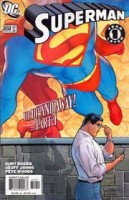 |
SUPERMAN #650 (PICK OF THE WEEK!)
Publisher DC • Writers Kurt Busiek & Geoff Johns • Artist Pete Woods
Oh, yes.
When you think about it, the thing about One Year Later is that, really, it doesn't matter so much what they do with a lot of the smaller characters around the DCU. A lot of them didn't really have anything wrong with them, and that's been reflected in the (perhaps surprising) lack of major status quo change in a lot of the books that have launched so far. The Big Two, however, did have something up - Batman and Superman had both lost their appeal, and we simply can't have that. Lacklustre story after lacklustre story, the feeling that nothing was being done with the characters - indeed, the feeling that the characters weren't quite there - all problems that needed addressing.
So a lot rides, therefore, on the OYL relaunches. It's an opportunity to bring new creative teams onboard and let them start from a point that isn't bogged down by what's gone before. It worked spectacularly well on Batman - and will hopefully continue to do so when Morrison and Dini get their hands on the books - but has it worked on Superman?
What do you think? This is Kurt Busiek we're talking about. If anyone was fit to write a Superman book, particularly at a time when there's a slump to be pulled out from, then surely it's him. And he doesn't disappoint here. This is fantastic stuff - it's not quite All-Star Superman, but it's easily the equal of Robinson's Detective Comics and arguably, therefore, the early highlight of OYL so far. And what makes it all the more remarkable is that it doesn't actually have Superman in it.
It's One Year Later, and Superman - like Batman - has been missing for that year. As we follow Clark and Lois from a park showing a cheesy Hollywood dramatisation of Superman's life to their work at the Daily Planet offices, however, the reason isn't immediately apparent - Clark's still around, so why has he given up being Superman? Why is he now using a signal-watch to summon Supergirl, apparently Metropolis' new protector? Well, it's a fairly guessable reason, revealed at the end of the issue, but it's not one I'm going to spoil just in case you haven't figured it out. Suffice to say, it sets up the premise of Busiek and Johns' opening arc somewhat intriguingly - we want to know both how things got this way, and how they're going to get back to how they should be.
In the meantime, though, Busiek is once again demonstrating (as he did with the wonderul Superman : Secret Identity) that to tell a great Superman story you don't necessarily need to have Superman himself in it. This is all about, as Robinson's Batman was, reestablishing the classic elements - so we quickly see Perry and Jimmy at the Planet in addition to Clark and Lois, while there's an update on what Lex Luthor's current status is. There's a lot of potential here - since the 1986 reboot, we've seen him as slightly-feared businessman, then (after his "death" and rebirth as "Lex Jr.") beloved tycoon, then respected President, and then (briefly) as outright criminal. I'm not quite sure how believable it is that he's escaped any legal consequences of everything that happened in Superman/Batman, but the idea of him as a fallen idol, a man now deeply mistrusted by the public and attempting to win back his empire, is so rich in possibilities and intrigue that I'm willing to overlook that. I've a feeling we're going to see Busiek wringing every inch of Lex's devious intellect out here, and I can't wait.
Meanwhile, it's also pleasant to see the new Supergirl actually being written quite well for the first time since her introduction; a world away from Jeph Loeb's annoying and scantily-clad teenager, she comes off more like the Matrix Supergirl of the early-mid 90s, and looks to have truly earned her stripes defending Metropolis in her cousin's absence. In the Planet offices, meanwhile, the quickfire dialogue positively sizzles - and you have to wonder if there isn't the potential for doing a Gotham Central kind of thing with a title that focuses on the newsroom.
Visually, it's ace as well. Pete Wood's self-inked pencils are very reminiscent of Tony Harris' work, but in terms of feel they also call to mind Leinil Francis Yu's distinctive work on Superman : Birthright. A great mix, in other words, and a style that suits the story being told perfectly. There are some lovely visual touches, from the raised "S" on Supergirl and the movie Superman's costumes providing a subtle link with Superman Returns, to the look of the new Kryptonite Man being a nice little nod to the Silver Age.
All in all, this is thoroughly great stuff. As I said when Detective Comics came out, this is what One Year Later is all about - restoring the topline characters to their rightful places, with the right people working on them; people who understand them. "It's been a good year," says Clark at the start of the issue. Well, it's shaping up to be another. A+
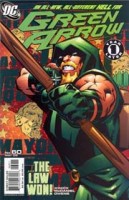 |
GREEN ARROW #60
Publisher DC • Writer Judd Winick • Pencils Scott McDaniel • Inks Andy Owens
And so we come to Green Arrow, perhaps one of the more eagerly-awaited of the relaunches despite the fact that it wasn't really until Kevin Smith's run a few years back that Ollie became a really bankable character. He is a good character, though, and in the right hands his own book can be truly great stuff.
This, meanwhile, is just "pretty good" stuff. The main problem it suffers from is that Winick hangs the whole issue off the completely massive twist of a really quite significant change to the book's status quo - unfortunately, said twist is actually given away not just by the issue's solicitations, but its cover. Which makes the fact that Ollie himself doesn't appear until the last page, upon which Winick makes the "big reveal", seem a bit silly.
Still, though, it's not a completely dead loss. I came into this book after having read little GA past Smith and Brad Meltzer's runs, and was expecting to feel alienated by not understanding the book's circumstances and supporting cast. Thankfully, Winick has got a good handle on what this whole One Year Later business means in terms of attracting new readers, and so sets up (presumably) established characters as if they're being introduced for the first time. The first half of the issue does plod a bit, largely due to being almost entirely expository in nature, but things liven up in the scene with (what I guess is a) villain-turned-vigilante Brick, and the interaction with an unseen-at-this-point Ollie (although I'm beginning to tire, coming off the back of his Batman run, of Winick's use of the phrase "brain donor" as an insult - it's becoming the equivalent of "spaz" in Brian Michael Bendis books, and it's just unrealistic to believe that so many characters would use such a specific phrase). It livens up even more with the introduction of Deathstroke, and knowing that he's soon going to be facing off against GA gives a pretty nailed-on reason to come back next month.
Still, though, given that so much of this issue is scene-sketching exposition, and that you know the big reveal the second you pick the book up, it's hard not to feel a little cheated at having actually forked out the cash for it. What it does offer, though, is enough promise for the reader to want to return next month - which is arguably the most important task for these relauched DC books at the moment. B+
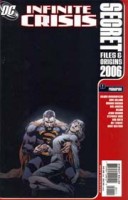 |
INFINITE CRISIS SECRET FILES & ORIGINS 2006
Publisher DC • Writer Marv Wolfman • Layouts Dan Jurgens • Finishes Jerry Ordway, Cam Smith, Art Thibert and Nelson
Well, you don't really need me to tell you what this offers - like last week's Teen Titans, it's filler, pure and simple. It's a little more to chew on for those who really can't get enough of Infinite Crisis. As such, it's completely inessential but enough of a stopgap if you're really getting into the swing of the story and can't wait for issue #6.
Basically, this follows Alex Luthor, Superboy Prime and Earth-2's Superman and Lois, and tells us what they've been up to inbetween the end of Crisis On Infinite Earths and the beginning of Infinite Crisis. Unfortunately, what it doesn't do is offer much in the way of searing insight that we hadn't already learned from the core title. We already know Alex's motivations, we've already seen him manipulating Superboy's emotions, and we've already seen Superman's desperation to save Lois and bring back the right Earth. All that this issue really does is shows us further example of all this.
What it doesn't do, either, is take the opportunity that is presented for it to clear up quite a big plothole that IC had already created. In the Epilogue, Alex states that Superman's part in the whole thing was "providing the last of the power necessary to break us out of that damned heaven I condemned us to permanently". However, on the same page, we've seen both Alex (masquerading as Lex Luthor) and Superboy leaving their "prison" frequently, to manipulate things on "our" Earth. So why, precisely, does he talk of needing Kal-L to break them free?
The art, meanwhile, is pretty patchy. Dan Jurgens is responsible for the whole book's layouts, and it's nice to see him back on Superman, but there's an inconsistent feel as a result of three different finishers, meaning that none of the sections bar the first (inked by Jerry Ordway) really feel like Jurgens work. There's also an extremely jarring panel in which Superboy appears to age about twenty years, which really snaps you out of the story somewhat.
As with Teen Titans, some of the more noteworthy moments involve glimpses into the ever-changing history and continuity of the DCU cropping up in that weird crystally wall stuff. That said, I'm starting to see this as a somewhat cynical nostalgia-inducing device, as - pleasing as it is to be reminded of all the different versions of Hawkman, or of Loeb/Sale's radical interpretation of the Challengers of the Unknown - it seems to be happening rather a lot lately, and such instances don't really seem to serve a purpose other than distracting readers from the slightly flat storytelling surrounding them. I could say the same thing, also, about the fleeting appearance of Blue Beetle, which does little other than make you wish he was still around.
When all's said and done, though, the biggest problem with this book is the price. As a mildly engaging piece of Crisis-related filler, it's fair enough; but slap a price of six dollars on it and you really wish there'd been something more worthwhile here - perhaps more of an exploration of how the various post-Countdown miniseries tied into the beginning of Crisis, or something. B-
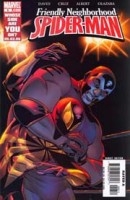 |
FRIENDLY NEIGHBORHOOD SPIDER-MAN #6
Publisher Marvel • Writer Peter David • Pencils Roger Cruz • Inks Oclair Albert & Victor Olazaba
And so Peter David's Spidey Book (am I the only one who thinks that would have been a better title? Oh, okay.) makes a quick reappearance on the shelves, just a couple of weeks after #5. And still... I don't know. There's still a lingering feel that PAD hasn't quite settled down with what he wants to do with this book yet.
Last issue felt rather like an out-of-continuity story - one that used the elements of the character that people knew, without feeling bound to a particular timeline or set of established continuity and circumstances (almost like an All-Star version, heh). This one does the same, but comes off like a confusing mishmash - so we have Peter, still teaching (though I don't read New Avengers and have been off Amazing Spider-Man for a while, I was under the impression that while living with Tony Stark, Peter was also working for him), yet Mary Jane and Aunt May are living in Stark Tower and interacting with Wolverine and Jarvis, while Spidey has his new costume. And yet Flash Thompson is suddenly out of his coma with no memory of not only the past few years of character development (back to being a lughead who rags on Peter and hero-worships Spidey), but also the incident that put him in said coma in the first place. Oh, and J. Jonah Jameson now thinks his son is Spider-Man.
Alright, so the Flash thing is explained away as "amnesia", but still. The melee of various elements of Spidey continuity certainly frazzles the brain a bit upon first reading, which is annoying, because if this could just have been purely placed as an out-of-continuity tale, there's plenty to enjoy. Regressing Flash to his past self may be controversial for the continuity freaks, but it does garner some good laughs; as do the interactions between Mary Jane and Logan, and Aunt May and Jarvis (indeed, these relationships have been written so well by Bendis, Straczynski and now David in recent months that you can't help wondering why it took someone so long to come up with them).
Simply put, David's biggest strength as a writer - dialogue that's funny but doesn't stray too far into downright sitcomness - is, at least, evident here. But the book still feels horribly confused. And the idea of a Mexican wrestler having a public bout with Spidey, at the end of which one of them will be unmasked... it just feels a little hackneyed, like it's been done before (indeed, it almost feels like a core part of the Spidey mythos), and even the attempts to introduce a sympathetic backstory to the wrestler character can't help with that.
Still, in terms of writing, it's at least an improvement on last time out (which, that said, I still maintain was a decent read despite the controversy the ending generated, controversy I was completely oblivious to when writing my original review). It's just a shame, then, that the art completely buggers it up. Where's Mike Weiringo gone? Presumably he won't be gone for long, but as fill-ins go, this is pretty lousy. The wrestling scenes see a sloppy attempt to ape 'Ringo's kinetic style, but worse, the character faces all look dreadful - horribly disproportionate, with no consistency on each character from panel to panel. Mary Jane suffers the worst, but nobody comes off particularly well unless they've got a mask on.
If you can get past the art, though - and sadly, it really is one of those examples where sloppy art makes the whole thing seem worse than it probably is - then this is, at least, another step in the right direction for this book. But come on. We know what Peter David is capable of, and he seems like he should be able to do great things with Spidey. The fact that there's another big crossover event coming up really isn't going to help him - but when the gaps crop up and there's a chance to do those Jenkins-style one-shots, he really needs to start delivering. B+
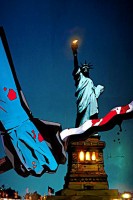 |
NIGHTWING #118
Publisher DC • Writer Bruce Jones • Pencils Joe Dodd • Inks Bit
Ouch. This is poor. This is really poor. This is arguably the first real failure of the whole One Year Later shebang, and on such a significant character, that's really not a good thing.
It's One Year Later, and Nightwing has moved to New York (is no-one else annoyed when New York shows up in DC books? New York is where Marvel happens. DC has Metropolis and Gotham and so on. I don't know when they introduced "real" places to the DCU, but it sucks). In fact, both Nightwings have moved to New York. Yep, that's right - there's an imposter running around pretending to be Dick. And his brutal actions in the opening pages of the issue - combined with the rather telling cover image (although, interestingly, the knife shown on the cover isn't actually used in the issue, even though another knife is used by Fake Nightwing) - leave us into little doubt as to who's under the mask, providing a groanworthy realisation for those who thought that that particular story would be over and done with once the Crisis shakes out.
The idea of Dick trying to find his way in a new city, while Jason Todd runs around brutally offing criminals dressed as Nightwing and thus smearing his good name, isn't an inherently bad one; and there's certainly, as with the better of the OYL titles, a decent amount of intrigue as to how things got this way. But Jesus, this is a lousy read. I've always tended to see Bruce Jones as something of a poor man's Greg Rucka, and he does nothing to dispel that here. Long term fans of Grayson (and yes, I resisted the temptation to say "Long term fans of Dick" there, aren't I mature?) will no doubt blanche at his casually hopping into bed with the first redhead he finds (yep, looks like that engagement to Barbara is off; also looks like we'll have to wait a while to find ot why), but you can sort of see their point. He's appallingly handled here, coming off more like an inexperienced hero finding his way in the world rather than one of the few characters in the DCU that's shown genuine growth and development in the past couple of decades (can we put this down to post-IC rejigging of timelines? I sincerely hope not). Indeed, you do have to wonder if anyone other than Chuck Dixon is actually capable of writing this character, although this issue will surely leave even the most ardent Devin Grayson-haters wishing she was still writing it. Meanwhile, my Nightwing knowledge is down, so I don't know if this Clancy person secretly knows Dick's secret or not - but if not, then if running into the pair of them in New York in the same day doesn't set some alarm bells ringing, that's just sloppy.
It's in the dialogue and voice, though, that the writing really stinks. Dick's pillow talk is cringeworthy, although not as cringeworthy as "Y-you're *gasp*.. m-meta human...", a line that is surely destined to go down alongside "What, are you retarded or something? I'm the goddamn Batman!" in DC's "All Time Worst" stakes. Jason, meanwhile, isn't much better - you get the impression that Jones hasn't actually read Judd Winick's Batman run, because his speech - from "Now days ya gotta do even the mop-up yourself!" to "You got sometin' stuck in your throat?" - is not only horribly grating, it's also an apparent attempt to put a "street", wiseguy accent where there clearly wasn't one before. Neither is the art particularly great - there's a bit of a Manga-style look creeping into some of the character faces at times, and the general visual style is flat and uninspired.
Interestingly, it's never actually stated that the "fake" Nightwing is Jason Todd - it's just an assumption the reader is clearly meant to make from his actions and from the cover. Quite frankly, the only thing I can see rescuing this book at the moment is if Jones pulled the rug out from under us with a massive twist along the lines of the doppelganger not being who we think he is. In fact, it would help if the guy calling himself Dick Grayson turned out to be a fake, as well. C-
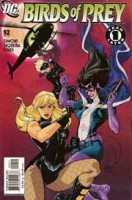 |
BIRDS OF PREY #92
Publisher DC • Writer Gail Simone • Pencils Paulo Siqueira • Inks Robin Riggs
For all that the Superman and Batman books are clearly standing out as the high watermark of the post-Crisis DC books, it seems as if the likes of Green Arrow and Birds of Prey are most indicative of the tone of the books in general - a few changes to the setup here and there, but nothing earth-shattering, and a good jumping-on point for new readers, particularly those who've meant to start reading a particular title for a while but have been put off by having to catch up with past continuity.
That's certainly the way I've been for a while with Birds of Prey (much as the title still makes no sense. What kind of a bird is the Huntress meant to be?). And the relaunch succeeds, at least in part, in providing a decent point to start reading; although, that said, there remain a few bewildering elements.
Indeed, aside from the changes to the team's lineup, this is pretty much business as usual. I'm not entirely sure what the situation was when this book left off, but to the new reader it gives the impression of - after having packed Dinah off to the Far East and brought in a new member - picking up at much the same place. The stuff with Huntress (and, later, "Jade Canary") facing off against Killer Croc, the Ventriloquist and Clayface certainly seems very much in keeping with what I know of BoP, and indeed provides most of the issue's better and more light-hearted moments.
It appears, also, that "the Society" are being set up as the regular antagonists for Oracle's organisation, which would seem to be a good idea in principle - after all, Calculator's recent revamp has basically turned him into the "anti-Oracle", so it makes sense to put them at loggerheads. On the other hand, though, it doesn't seem to wise to be bringing in elements of the pre-Crisis tie-in series Villains United just yet; seeing the Society still active before we know how the Crisis has shaken out removes one layer of mystery, while the whole thing is confusing for those of us who didn't read VU and aren't really sure who's on which "side" of the bad guys.
A decent enough read, though - solid if unspectacular, business as usual, and the same goes for the art. Unlike Green Arrow, it doesn't really offer a massive hook for those new readers, but sets out its stall as the first issue of a new story well enough for the existing ones. B
About this entry
- By Seb Patrick
- Posted on Sunday, March 19 2006 @ 11:31 pm
- Categorised in Comics
- 0 comments
